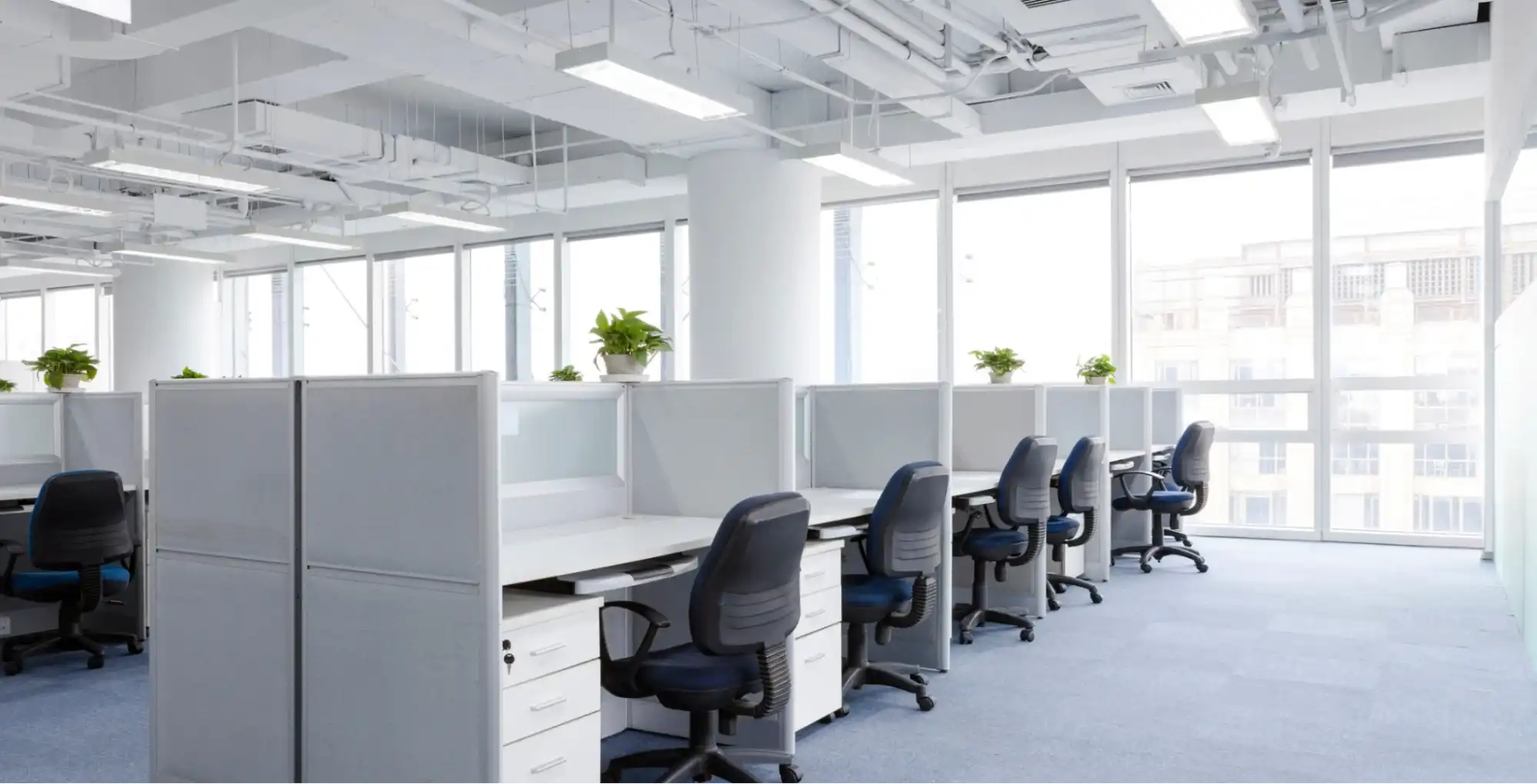The way businesses approach office space is evolving. The traditional saying of a “one size fits all” office is no longer relevant since hybrid teams are rapidly scaling and changing workplace expectations.
Whether you’re a solo founder, a scaling startup, or an established enterprise, your office space can directly impact productivity, collaboration, and long-term success. But with so many options serviced, managed, and leased, how do you know what’s right for you?
In this guide, we’ll walk through the key features, trade-offs, and benefits of serviced offices and other office types. By the end, you’ll clearly know which workspace solution fits your business best.

Contents
What Is a Serviced Office?
Let’s start with the question a lot of entrepreneurs end up asking first “What is a serviced office?”

A serviced office is a fully equipped, plug-and-play workspace that’s managed and maintained by a third party. You just walk in, set up your laptop—and boom, you’re in business. No messing with furniture, no utility setup, and no long, complicated lease contracts.
Most serviced offices typically include:
- Furniture (desks, chairs, meeting tables)
- High-speed internet and utilities
- Cleaning and maintenance (yes, even that coffee spill from Monday)
- Reception services, admin support
- Shared amenities like kitchens, breakout areas, and meeting rooms
These serviced office solutions are made for flexibility—they’re often rented out on a rolling monthly basis, so you’re not locked into anything long-term, unless you want to be.
You’ll find fully serviced offices in coworking hubs and business centers, and sometimes, even in places you wouldn’t expect—like upper floors of department stores or old banks that got turned into workspace gold.
Ideal for? Freelancers, remote teams, startups, or anyone in limbo—relocating, growing fast, shrinking down, testing waters, the whole chaotic ride.
For example, say a startup’s expanding into a new city—they grab a serviced office to rent for six months to see how it goes. No significant risk, but a whole lot of room to move.
What Is a Managed Office?
A managed office sits right in the middle of the workspace spectrum—between the convenience of serviced offices and the full-on commitment of leased offices. It’s for businesses that want their space to feel like their own, but without the stress of managing it.

Here’s the deal: you get a workspace that’s designed around you. From floor plans to branded walls, even the furniture—it’s all tailored to your team. But instead of hiring contractors, IT staff, and a facilities manager, you’ve got a provider handling all of that, quietly in the background.
Think of it like this: it’s more freedom than a serviced office space, but you won’t do full DIY like in a lease. Most managed offices run on mid-range contracts—12 to 36 months—and can flex based on your headcount, how you work, and the kind of vibe you want your office to give off.
Here’s what a managed office space usually comes with:
- A custom fit-out—your layout, your brand, your way
- Private meeting rooms, chill zones, branded signage
- High-speed internet, printers, office tech, utilities
- Dedicated IT and facilities support (so when things break, they don’t stay broken)
Best for? Businesses in scale-up mode want a workspace that feels permanent, but isn’t locked in like a traditional lease. It’s that “grown-up” office vibe without the corporate weight.
A real-world example: A tech start-up with 50 staff is hitting a growth spurt. They want their own space—with meeting rooms, team pods, and a custom wall mural—but they’re not ready to deal with aircon repairs and Wi-Fi outages. A managed office gives them all of that, minus the logistical chaos.
What Is a Leased Office?
A leased office or office space for lease gives you the most freedom in how you work, and the most on your plate too.

When you lease an office space, you’re locking into a long-term contract with a landlord, usually between 3 and 10 years. And from there—you’re the boss. Fit-outs, furniture, IT setup, utilities, repairs—everything’s on you.
Yes, it’s a big commitment upfront, but what about the trade-off? You get full control. You can decide how it looks, how it feels, and how it works for your team, but most importantly, how it grows over time.
Here’s what a leased office setup looks like:
- An unfurnished space that is often just a concrete shell, waiting for your vision
- Long-term contracts that offer stability, but little wiggle room
- Total creative freedom, such as layout, branding, and lighting. All yours
- Full responsibility for bills, maintenance, and equipment. The whole thing
It’s ideal for: Companies with steady teams, strong brand identity, and a long-term growth plan they’re serious about.
Example? A law firm leases an entire floor in a downtown building. They build it from scratch—custom boardrooms, quiet private offices, even scent diffusers (fancy, right?), all designed to reflect their brand. It’s not just an office, it’s their space, built to match their brand, top to bottom.
Quick Comparison Table
To help you compare and think, here’s a table of its breakdown:
|
Feature |
Serviced Office | Managed Office |
Leased Office |
| Setup Time | Ready right away | 2–8 weeks | 2–6+ months |
| Flexibility | High (monthly) | Medium (1–3 years) | Low (3–10 years) |
| Customization | Limited | Medium–High | Full control |
| Cost Predictability | High (all-in-one) | Medium (bundled) | Low (variable) |
| Ideal For | Startups, remote teams | Scaling businesses | Established companies |
Pros and Cons of Each Option
Let’s break down the advantages and drawbacks for each workspace type.
Serviced Offices
What’s good
- It is ready to use where you can move in almost right away
- Barely any setup needed
- You don’t pay much at the start
- You pay all bills in one monthly payment.
- You pay all bills in one monthly payment.
What to watch out for:
- You can’t really choose how it’s going to look like.
- These shared spaces might feel less private.
- If you stay too long, the monthly costs might add up.
Managed Offices
Why teams like it:
- Can be designed your way but without the extra work.
- Good if you need space for a year or two.
- You get your brand on the space without a long lease.
- Easier to grow into than full-on leased offices.
But heads-up:
- Can cost more than doing it all yourself.
- Might not be as flexible as the serviced offices.
- Quality depends on how well the provider runs things.
Leased Offices
Why some businesses go all-in:
- You can choose the look and setup.
- Cheaper over the long run.
- Fully private and yet still branded.
- Great for stable, long-term teams.
But be ready for this:
- Big costs at the start and along the way.
- Might take a long time to set up.
- You’ll need your own staff to manage the space.
- It might be difficult to change things up if you plan to.
How to Choose the Right Workspace for Your Business?
Choosing an office isn’t just about space, it’s more about the atmosphere and its environment. It should feel right like how it fits the way your team flows, where you’re headed, and the bigger picture you’re building toward.
Here are the some key questions to ask yourself:
1. How big is your team and how fast is it growing?
- Are you expanding quickly or staying steady?
- Do you need room for 5, 50, or 500 people?
2. How much can you spend?
- Can you handle a long lease, or is flexible pricing a better fit?
- Have you thought about extra costs like furniture, setup, and bills?
3. How long do you plan to stay?
- Are you testing a market or looking for a long-term HQ?
4. How much control do you want?
- Do you prefer something that is ready-to-use or do you want to design everything?
- Are you okay running the place yourself?
5. What’s your brand visibility need?
- Do you need a space that impresses clients?
- Or is your team remote and doesn’t need a physical office?
Answering these questions will steer you toward the right option whether that’s serviced offices, managed office space, or a leased office space.
Othership’s Role in Workspace Solutions
At Othership, we understand that no two businesses work the same, or grow the same. That’s why we offer a wide mix of flexible options, from serviced office solutions in top-tier locations, to managed offices, and short-term office space for lease when you just need something practical that fits.
Whether you’re after fully serviced offices that are move-in ready, or you’re exploring managed office spaces for something more custom, Othership helps you compare, choose, and move in without the stress. No red tape, no long waits, just the right workspace, at the right time.
Final Thoughts
Choosing the right workspace can move your team forward—or quietly slow things down. With hybrid setups, remote work, and new ways to get things done, it matters more than ever to pick a space that fits how your business actually works. Not just today, but for what’s next.
Quick rundown:
- Serviced offices are quick and easy that is great for startups or remote teams who just need to move in and get to work.
- Managed offices are the sweet spot; you get a space that feels like your own, without the stress of running everything yourself.
- Leased offices give you the reins completely, suited for companies that are settled, with long-term plans in mind.
Still unsure what fits?
Check out Othership’s growing list of serviced office options and flexible workspace solutions to find something that really works for your team—not just on paper, but in real life.




You must be logged in to post a comment.